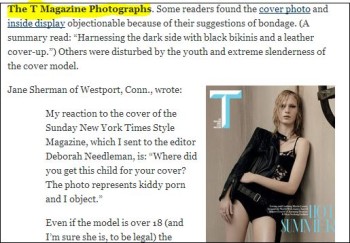
NYT public editor Margaret Sullivan addressed concerns about a T magazine cover. (Credit: NYT, screenshot, highlight added)
A discussion on Photoshopping images in the news was recently brought up after a New York Times editor told public editor Margaret Sullivan that she almost doctored a photo of a model to make the model less skinny.
Deborah Needleman, the editor for T: The New York Times Style Magazine, had said, as iMediaEthics tweeted at the time:
NYT T mag editor ‘considered adding some fat to [a model] with Photoshop’ nyti.ms/14hTIN8
— iMediaEthics (@imediaethics) May 13, 2013
In response to Needleman’s remark — and public reaction to that comment about a Times’ editor’s willingness to use Photoshop to alter an image — Sullivan asked standards and photo editors at the Times about Needleman’s proposed Photoshop job and reported what she found out in a May 19 column.
While Needleman said it’s fine — and sometimes expected — to doctor fashion photos, she and other editors at the Times (thankfully) agreed that news photos are a different ballgame. According to Sullivan, T’s fashion photos are viewed as “an exception” to the no-Photoshop rule.
Times assistant managing editor for photography Michele McNally said news pictures aren’t doctored and “the standards are very clear.” However, McNally explained “fashion is fantasy” and “totally manipulated.” As such, McNally argued that “readers understand” fashion photos may not be 100% real.
Likewise, associate managing editor for standards Phil Corbett said to Sullivan that readers have a “different expectation” for fashion photos.
The matter is complicated, Sullivan wrote, because even though the photos in question are fashion and therefore possibly Photoshopped, newsroom staff work on the magazine and “T magazine is still a New York Times editorial product.” And other fashion sections of the paper — like Styles and the Times Magazine — don’t allow Photoshopping images outside of minimal adjustments for “color-toning and brightening,” she said.
Reader “Mark” responded to Sullivan’s post in the comments, highlighting the problem with the double standard.
“As Ms Sullivan correctly points out, T Magazine is still an editorial product of The Times, and should adhere to the same journalistic standards as the rest of the newspaper,” Mark wrote. “To allow a separate standard for fashion photography creates a slippery ethical slope.”
Sullivan called for the Times to have “the same standard” across the board for photos or include “some transparency.”
“For example, a brief statement in each issue of T stating its photo practices would help,” she suggested.
Of course issues related to disclosing Photoshop aren’t limited to fashion pictures. iMediaEthics has recently written several times about less-than-transparent practices at New York newspapers when doctoring photos.
iMediaEthics wrote in February when Times T Magazine editor Needleman told Sullivan she “regretted” the magazine’s lack of diversity.





